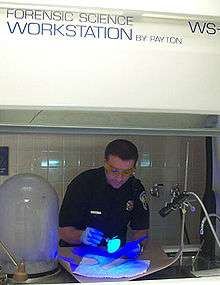Crime lab
A crime laboratory - often shortened to crime lab - is a scientific laboratory, using primarily forensic science for the purpose of examining evidence from criminal cases.
Lab personnel

A typical crime lab has two sets of personnel:
- Field analysts - investigators that go to crime scenes, collect evidence, and process the scene. Job titles include:
- Forensic evidence technician
- Crime scene investigator
- Scenes of crime officer (SOCO)
- Laboratory analysts - scientists or other personnel who run tests on the evidence once it is brought to the lab (i.e., DNA tests, or bullet striations). Job titles include:
- Forensic Technician (performs support functions such as making reagents)
- Forensic Scientist/Criminalist (performs scientific analyses on evidence)
- Fingerprint Analyst
- Forensic Photographer
- Forensic Document Examiner
- Forensic Entomologist
Crime labs
United States
In the United States, crime labs may not be publicly nor privately operated, although private laboratories typically do not respond to crime scenes to collect evidence. Public crime labs are organized at the city, county, state, or national level. A law enforcement agency that does not operate its own crime lab usually has free access to a higher level laboratory for analysis of their evidence. Most states have their own crime labs, for instance Oklahoma has the OSBI, many other places have smaller yet still sufficient crime labs.
The Los Angeles Police Department founded the first crime laboratory in the United States (1923), followed by the Bureau of Investigation (1926), forerunner to the Federal Bureau of Investigation. (Every Contact Leaves a Trace, Connie Fletcher, St. Martin's Press, New York, 2006, interview with crime lab director)
Crime labs in popular culture
The term "crime lab" has become a part of popular culture, largely due to the TV dramas. Some of the more famous shows are:
- Bones (TV series)
- "Castle (TV series)"
- CSI: Crime Scene Investigation and spin-offs CSI: Miami and CSI: NY
- NCIS
- Quincy, M.E. - a 1970s television show featuring crime lab personnel and procedures.
Several non-fiction television programs, document the resolution of criminal cases based on the scientific analysis of the evidence:
See also
External links
- FBI Crime Lab
- Arkansas State Crime Lab
- Census of Publicly Funded Forensic Crime Laboratories Bureau of Justice Statistics
- Forensic Science Laboratories: Handbook for Facility Planning, Design, Construction, and Relocation National Institute of Standards and Technology
- US Postal Inspection Service Forensic Lab
- Reddy's Forensic Page - link to US and international forensic laboratories